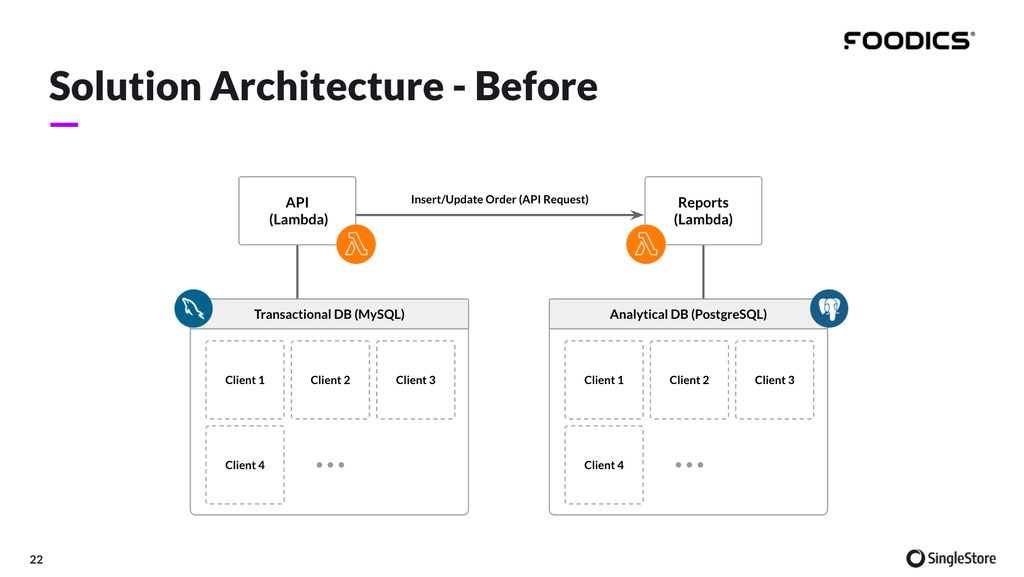
SaaS innovator Foodics revolutionizes the way companies and restaurants handle real-time reporting, inventory management, order submission and employee operations.
Headquartered in Riyadh and available across 17 countries, Foodics is growing rapidly around the world — meaning their need to process data at faster speeds and deliver real-time insights is growing, too. Using their application dashboard, users can quickly glean insights on how their business is performing. This performance can be analyzed per branch, payment methods, products and more. And, users can easily apply filters, group different metrics together and change analysis dimensions to find the exact metrics they’re looking for.
We sat down with Foodics to hear more about their database journey in our latest webinar, “Supercharging SaaS Applications: The Foodics Story.”
Foodics’ Journey to SingleStoreDB
As Foodics grew, so did its user base — effectively moving the company into a new SaaS category: they were now dealing with a data-intensive application. Unfortunately, Foodics’ data architecture at the time wasn’t able to meet those requirements.
“Like any tech company, we started with MySQL,” said Mohammed Radwan, head of engineering at Foodics. “We started with MySQL because it was compatible with what we had, and was easy to use. The thing is, with MySQL, it lacked analytics capabilities. It’s more of a transactional database, not for analytics. It did fill its purpose for a while, but then we needed to grow and expand — and that’s why we chose PostgreSQL.”
It’s a journey not unfamiliar to many SaaS companies and app providers — starting with single-node, open-source databases to get their platform off the ground. Yet as Foodics soon discovered, their existing service provider came with a series of challenges that directly impacted their end users, including:
- The inability to scale up and scale out
- Ongoing service instability
- A lack of data integrity
- Constant re-balancing of data
- Low concurrency that only supported 200 users
- A lack of AWS ecosystem support

Foodics knew to effectively and efficiently accelerate their SaaS app performance, they needed a database that eliminated these challenges while setting them up for future success.
“When we faced these things we decided, okay, it’s time to move on,” says Radwan. “We need to look for something that is more reliable, that allows us to grow and that we can rely on for the next five, 10 or 20 years moving forward.”
That realization led the company to SingleStoreDB.
eBook: A 5-Step Guide to Supercharging Your SaaS Apps
From Subpar to Supercharged
“We started asking ourselves some questions: what do we need?” says Radwan. Foodics’ list of database criteria included:
- Placing all analytics-related data into a single, unified data store.
- A performant analytics engine (with Columnstore) to democratize data access
- Real-time and near real-time analytics
- High concurrency to support a large number of reports being generated simultaneously
- A fully managed database with low TCO that freed up engineering teams
- A scalable solution that supported ongoing growth
- High availability with little-to-no downtime
Foodics’ search led them to an article written by Jack Ellis, co-founder at Fathom Analytics, detailing how SingleStoreDB had replaced MySQL, Redis and DynamoDB for the website analytics company. SingleStoreDB checked the boxes for what Foodics wanted in a database — however, the engineering team needed to run their own stress tests: “Once we settled and once we agreed on how we’re going to do things, we started some POCs — proof of concepts. We wanted to make sure that what we see or what we hear is real, because it was almost impossible to be real,” says Radwan.
Radwan and the Foodics engineering team started pushing SingleStoreDB to the limits with stress-testing that included:
- Creating around 10 billion rows
- Using complex queries (conditional aggregation, sub-queries, etc.)
- Inputting wide date ranges
- Simulating concurrent reads and writes
- Simulating heavy loads with concurrent connections
For Foodics, the rest is history. SingleStoreDB proved its ability to stand up to growth, data size and ingest requirements, truly cementing its position as the only database with the speed and scale built for data-intensive applications.

“What was the impact for all of that? First of all, what we’re focused on is the customer satisfaction,” says Radwan. “So you can imagine if you have a customer complaining all the time about reports…eventually they’ll get tired and churn. So this is something we were looking not to have.”
“Thankfully, we were able to improve the performance of our queries and performance of our reports by more than 60% — some reports were executed within the range of 400 milliseconds, now they’re executed within 60 milliseconds.”
“Now, we’re able to scale without worrying, knowing that we will have more concurrent users because we get more customers every day. And the offer we got from SingleStore was great — for that, we have 10x the power, performance and cost efficiencies.”
Get the Full Foodics Story
To hear more about how Foodics powers their business with SingleStoreDB, check out our latest webinar, “Supercharging SaaS Applications: The Foodics Story “





